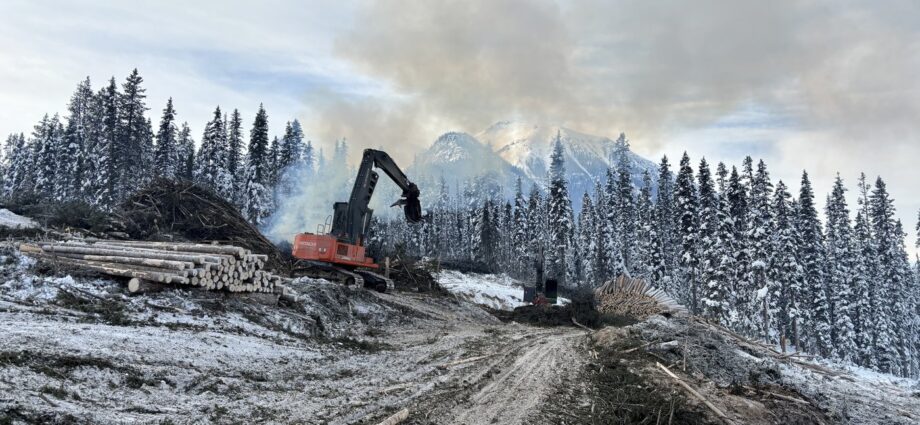
By Peter Shokeir, Local Journalism Initiative Reporter, Jasper Fitzhugh
January 14, 2025
Parks Canada assures it is actively preparing for the upcoming wildfire season through risk reduction work in Jasper and Banff national parks this winter.
Natalie Fay, external relations manager for Banff National Park, said in a media briefing Parks Canada uses a variety of tools and strategies such as prescribed fires, mechanical logging and tree thinning as well as the creation of community fireguards to help reduce the impacts of wildfire and climate change.
“While we can never completely eliminate the risk of wildfire, Parks Canada is taking important steps to reduce that risk across the mountain national parks using safe and effective fire management,” Fay said.
“Parks Canada works year-round to reduce the risks of wildfire and to ensure we’re prepared to respond in the event of a wildfire across the mountain national parks,” she added. “Our agency is taking action to create healthy fire-resilient landscapes and communities.”
In late July, the Jasper wildfire forced the evacuation of 25,000 people and destroyed nearly a third of the townsite. Parks Canada has since been accused of not doing enough to prevent the wildfire by many critics, including Conservative Party leader Pierre Poilievre and Alberta Premier Danielle Smith.
In a Dec. 14 radio interview, Smith accused the federal agency of showing no inclination to work with the provincial government to clear the deadwood on the west side of Jasper.
Fay noted Parks Canada employees in the Jasper and Banff field units live and work in these areas themselves. In addition, the agency strives to keep both residents and visitors aware of what they are doing to keep these communities safe.
In Jasper National Park, Parks Canada is finalizing a wildfire risk reduction strategy to guide these efforts over the next five years. This winter, the agency is focusing on vegetation management and fireguard enhancements.
To the west of Jasper, Parks Canada is clearing an additional 100 hectares of vegetation adjacent to the previously treated 360 hectares in the Pyramid Bench and the Community Fireguard areas.
David Argument, resource conservation manager for Jasper National Park, reported they were currently in the contracting phase and hoped to start clearing these 100 hectares by mid-February.
“Of course, we are confined by winter frozen-ground conditions, so we need to get that [work] underway as soon as possible before spring conditions return,” Argument said.
Although they were originally planning to extend the 360 hectares of treated area using prescribed fire as a tool, crews are moving back to mechanical removal to expedite the process.
Fire crews are working around the wastewater treatment plant and Pine Bungalows. Activities include felling trees, limbing branches and burning debris piles on-site to reduce wildfire fuel loads.
At Patricia Lake, Parks Canada will conduct additional fuel reduction work. This work will support the broader FireSmart initiative to create defensible spaces and improve emergency response access.
As for Banff National Park, work is underway to create a Lake Louise community fireguard. The fireguard will be about 165 hectares and run from the south slope of Mount St. Piran behind the Fairmont Chateau Lake Louise to the parking lot and ski runs of Lake Louise Ski Hill on Whitehorn Mountain.
“This will help reduce fuel and the risk of wildfire to the Lake Louise community as well as the wider Bow Valley,” Fay said. “Mechanical tree removal has already started, and pile burning will continue as specific conditions are met throughout the winter.”
Fay estimated it would take two or three winters to complete the 165.4-hectare fireguard.
In the area of MD of Bighorn, Canmore and Kananaskis Country, a multi-year fireguard project began in late 2024 to better protect the region. Through several phases over the next three to five years, several areas such as Stoneworks Creek, Harvie Heights and the Banff east park gates will have about 200 hectares of forest removed. An additional 116 hectares of forest will be thinned in the area.
In Kananaskis Country near Kananaskis Village, the area of Ribbon Creek has ongoing fireguard work taking place. It is planned to burn about 260 hectares of forest and part of a larger 7,900-hectare prescribed fire plan that is broken into several phases. This is an Alberta Parks project.
Mechanical tree removal is taking place in the Tunnel Mountain area near the town of Banff over the next two winters. This work covers an area of 220 hectares and is expected to reduce the wildfire risk to the nearby communities of Banff, Canmore and Harvie Heights.
On top of this work, Parks Canada is currently in the planning phase of an additional 1,413 hectares of wildfire risk reduction work within a 15-kilometre radius of the town of Banff.
When it comes to FireSmarting the townsites themselves, Argument said Parks Canada works closely with municipal governments and residents within these communities. He noted new development guidelines for Jasper’s rebuild are directing more fire-resilient buildings.
The agency will also be working with municipalities to encourage the replacement of existing cedar shakes on roofs and is looking at upgrading its own infrastructure.
“Things like the Jasper Visitor Centre, which is an important heritage building in town, has cedar shakes, and we’re assessing options there for removing that risk,” Argument added.
As for whether wildfire risk reduction work will impact the natural aesthetic of these mountain parks, Jane Park, fire management specialist for Banff National Park, noted they consider both the aesthetic and cultural values that Canadians and visitors have in mind for protected areas.
“I do think that over time, the public has gotten used to large carpets of mature forests,” Park said. “That is not really historically what our landscapes look like.”
Subscribe to our newsletter.
She noted mountain areas often have open forests and grasslands, and Parks Canada needed to balance its wildfire risk reduction with restoring some of those open habitats while also getting the public used to seeing other native plant communities.

